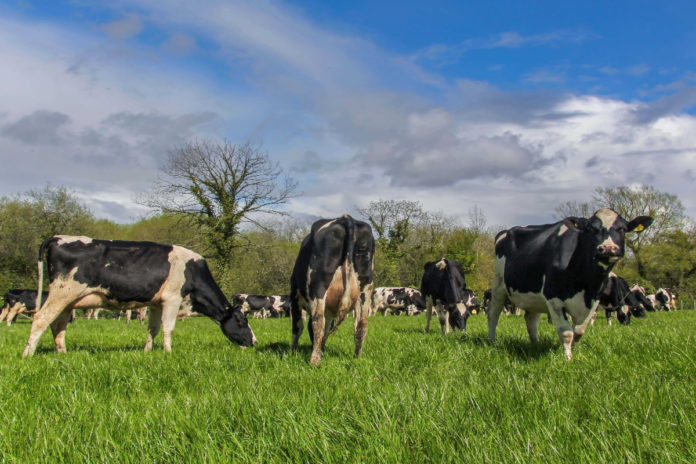“Agricultural emissions did not reduce during COVID-19 restrictions and are now 15% higher than the 1990 level.”
That is what the EPA (Environmental Protection Agency) has concluded following the release of its provisional greenhouse gas emissions figures for Ireland for 2021.
It reports that agricultural emissions have increased for the second consecutive year but fell from 2018 to 2019.
Agriculture emissions in 2021 were 23.1 Mt CO2eq, an increase of 3.0% on 2020, EPA data shows.
According to the agency, the most “significant” drivers for the rise in ag emissions in 2021 were:
- Increased use of synthetic nitrogen fertiliser – 5.2%;
- Higher dairy cow numbers – 2.8%;
- Increase in milk production – 5.5%.
In a statement, a spokesperson for the agency said:
“This is the 11th consecutive year that dairy cow numbers rose. Milk output per cow also increased (by 2.5%).”
“Therefore, increased production was driven by a rise in livestock numbers in conjunction with an increase in milk yield per cow. In 2021, total cattle numbers increased by 0.8%.
“In 2021, liming on agricultural soils increased by 49.5%, a welcome measure in improving soil fertility, which should lead to a reduction in fertiliser nitrogen use in future years.”
LULULCF
The agency lists Land-Use, Land-Use Change and Forestry (LULULCF) separately to assess the main sectoral emission trends.
It consists of six land use categories as follows:
- Forest Land;
- Cropland;
- Grassland;
- Wetlands;
- Settlements;
- Other Land;
- Harvested wood products.
When included in total national emissions, this sector accounts for 11.2% of the total emissions last year.
The sector is a net source of CO2 eq emissions in all years 1990-2021, the EPA says.
The main source of emissions is the drainage of grasslands on organic soils and the exploitation of wetlands for peat extraction.
Forest land and harvested wood products are a carbon sink (CO2 removal) for all years 1990-2021.
Furthermore, the EPA points out that the carbon sink associated with forest land is on a declining trend. It cited the age profile of existing forests and a “declining afforestation trend” as the primary factors.
| Million tonnes, CO2 eq | 2020 | 2021 | % Change 2020-2021 | % Change 2019-2021 |
| Agriculture | 22.431 | 23.097 | 3.0 | 4.3 |
| Transport | 10.285 | 10.912 | 6.1 | -10.5 |
| Energy Industries | 8.738 | 10.272 | 17.6 | 8.8 |
| Residential | 7.400 | 7.040 | -4.9 | 2.8 |
| Manufacturing Combustion | 4.552 | 4.593 | 0.9 | -0.7 |
| Industrial Processes | 2.107 | 2.460 | 16.8 | 8.5 |
| F-Gases | 0.739 | 0.738 | -0.2 | -14.7 |
| Commercial Services | 0.843 | 0.817 | -3.0 | -2.3 |
| Public Services | 0.689 | 0.663 | -3.8 | 1.6 |
| Waste | 0.982 | 0.937 | -4.5 | -5.5 |
| LULUCF | 6.943 | 7.767 | 11.9 | 12.6 |
| National Total excluding LULUCF | 58.766 | 61.528 | 4.7 | 1.1 |
| National Total including LULUCF | 65.709 | 69.295 | 5.5 | 2.3 |
[Source: EPA]
Summary:
Overall, the EPA’s figures show an increase in emissions of 4.7% in 2021 compared to 2020 – when Covid restrictions had led to a “significant” lowering of emissions.
In total, in 2021, 61.53 million tonnes of carbon dioxide equivalent (Mt CO2eq) were emitted, with emissions 1.1% above 2019 pre-COVID restriction levels.
The increase, it says, is “mostly due to a significant increase” in emissions from the energy industries sector.
It points to a tripling of coal and oil use in electricity generation in 2021, with increases also in the agricultural and transport sectors.
International aviation:
- In 2021, the EPA says total international aviation contributed 1.3 Mt CO2 from over 52,500 return flights from Irish airports;
- International aviation emissions averaged over 3.0 Mt CO2eq/year before COVID pandemic.
Energy industries:
- Increase of 17.6% in 2021 – tripling of both coal and fuel oil use in electricity generation;
- Peat consumption has continued to decline, by 67% in 2021, and at “an all-time low” within the power generation sector;
- 9% reduction in natural gas use (some plants offline for a time in 2021)
- Drop from 42% to 35% in electricity generated from renewables;
- Increase in the emissions intensity of power generation by 11.9% in 2021 to 331 g CO2/kWh compared with 296 g CO2/kWh in 2020.
Residential:
- 04 Mt CO2eq in 2021;
- 8% above pre-pandemic levels in this sector;
- Warmer weather, rising fuel prices towards the end of the year and easing of COVID restrictions led to “substantial” reductions in coal, peat and kerosene use for home heating.
Transport:
- 1% rise in transport emissions;
- Emissions remain 10.5% below pre-pandemic levels;
- Road transport emissions increased from 9.7 Mt CO2eq in 2020 to 10.3 Mt CO2eq in 2021.
- At the end of 2021, just under 47,000 battery electric (BEVs) and plug-in hybrid electric (PHEVs) vehicles in Ireland.





